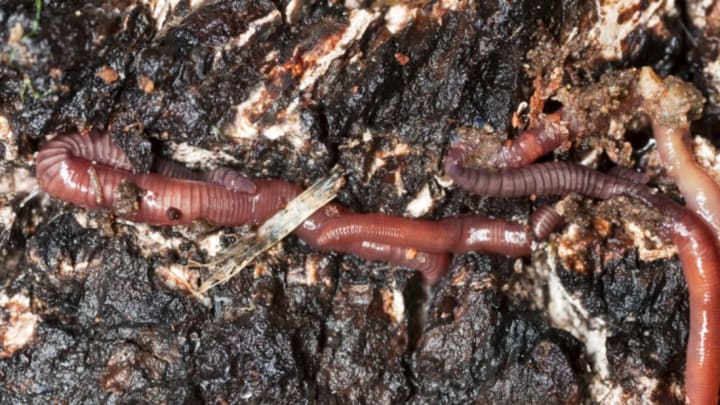Reader Bruce wrote in to ask, “When there is a heavy rain, worms climb out on the pavement, only to die when the rain stops. Why do worms commit suicide?”
Worms coming topside during and after rain used to be explained as them simply trying not to drown in water-logged soil. As biologists learned more about annelids (the group that includes earthworms, ragworms, and leeches), though, we figured out that some of them breathe a little differently than most land animals, and don’t drown as easily as you or I would in a watery hole in the ground.
Earthworms breathe by passing oxygen and carbon dioxide through their skin. For the oxygen to get through the skin and into the worms’ bloodstream properly, there needs to be some moisture on the skin, so the worms produce mucus to keep them moist and slimy. Moisture in the ground keeps the mucus from drying out, so soil that’s a little wet actually helps the worms breathe easy. Even if the soil is very saturated or an earthworm is submerged in water, it can survive as long as there’s sufficient oxygen to pull in through the skin.
Drowning in a rain shower, then, isn’t really a big concern—most of the time. Different species consume oxygen at different rates, sometimes at different times during the day, so some are more at risk for running out of oxygen in wet soil than others. In 2008, zoologists in Taiwan looked at two worm species, one that surfaces when it rains and one that doesn’t. They found that the surfacing worm consumed oxygen at a faster rate—especially at night—and didn’t tolerate total water submersion all that well. They could stay underground for a little while when it rained during the day, but had to come up sooner if it rained at night. The other worm consumed oxygen at a lower rate and could survive underground with lower oxygen concentrations.
So, drowning in wet soil is a concern for some earthworms, but not all of them. But is there something else that drives them aboveground?
Some biologists think that worms come up to reproduce and/or make long trips, both of which are easier to do aboveground than in the confines of the soil. Since they need to stay moist to breathe, they hold off on these activities until the surface is nice and wet with rain and there’s a lower risk of drying out.
The mating 'n movement hypothesis is supported by the type of worms you see during and after rain. As Phil Nixon from the University of Illinois explains:
“If the other factors were the driving influences, large numbers of juvenile worms should also be present, but the vast majority appears to be adult red worms with occasional adult nightcrawlers. When worms are brought to the surface with electricity, worm-grunting, or chemicals, many more worms are present. It is obvious that only a small percentage of the adult red worms are emerging during heavy rains. Perhaps this represents the small percentage of the population with the colonial spirit.* It appears somewhat similar to the small percentage of the world's people with a colonial spirit that immigrated to this continent and became our ancestors.”
Now, coming to the surface can be risky. There’s hungry birds, careless humans, and the possibility that a worm will get marooned on a sidewalk and dry out. If they’re coming up to mate, though, the risk involved may be overcome by the drive to reproduce. Surfacing isn’t necessarily suicidal, either. The worms don’t die, like Bruce thought, as soon as the rain stops, and many do make it back underground before they’re in danger. If death was guaranteed, we’d have no surfacing worms left to wonder about.
*Or maybe the ones that are able and ready to reproduce.
